Estonian Circular Design in New York City
Discover the Soul of Estonian Design: Tradition Meets the Future in Circularity and Digital Innovation
Discover the Soul of Estonian Design: Tradition Meets the Future in Circularity and Digital Innovation
Nestled in the heart of Northern Europe, Estonia has emerged as a powerhouse in the global design and digital innovation scene. Join us at Upmade in Estonia to learn how the of traditional core of minimalist philosophies of Estonian design became the cutting edge of sustainability and digital innovation.
This exclusive event is taking place for the first time in New York City, with top design leaders from Estonia in attendance who will share and discuss the roots of Estonian Design, its unique aesthetics, and its contemporary successes. You will find out why this tiny country is now recognized as having the “most unicorns per capita in Europe” and “the most start-ups per capita in Europe,” and how it became the world’s first 100% digitally transformed society. You will hear the backstory of the startup culture where products like Skype were born, and how Estonia became the world leader in digital governance, its innovative e-Residency program, and how this is revolutionizing the creative and entrepreneurial landscape.
Woola
Myceen
Reet Aus
HYTI
kelpman textile
johanna ulfsak
Piret Loog
LUKS
LAURASAKS
Cervo Volante
SILE LUIK
K i l l u d
Heiter X
NüüD
Studio Raili Keiv
Elize Hiiop Jewellery
Tarmo Luisk
LUM
Filaret
By Urmas Lüüs
Karlotta
Leonardo Design
Olustvere puidukoda / Mirjam ja Markus Pärnamets
Ideeklaas
Hannah Segerkrantz / Kiukivi
Margit Terasmees
IKIGI
Kärt Summatavet
Riina O
RAIKU Bio Packaging
Andres Ansper
DiMa Estonian Academy of Arts (Sandra Luks, Argo Tamm, Cärol Ott, Reet Aus)
HUUM
JALG
Krista Lehari Jewellery
Kristel Kuslapuu
SJX by Juhan Soomets
Maria Rästa Design
Arro Porcelain
Elmet Treier design
Read more: https://www.facebook.com/events/7407652605984775/?active_tab=discussion

Lessons from Finland’s attempt to transition to a circular economy.
Finland embarked on a pioneering journey towards a circular economy eight years ago, setting ambitious targets to reduce material consumption and transition away from a linear model by 2035. Despite significant innovation and collaboration, challenges persist, particularly in curbing material usage, which remains one of the highest per capita in Europe. The Finnish experience offers valuable insights, emphasizing the importance of stakeholder inclusion, innovation, education, and science-driven goal setting.
The concept of a circular economy, characterized by the continual reuse of materials instead of their disposal, has gained traction globally. Finland’s circular economy roadmap, developed in 2016, aims to cap material consumption, double circularity, and enhance resource productivity by 2035. However, achieving these goals requires significant systemic changes across various sectors, including forestry, agriculture, construction, and transport.
To address its high material footprint, Finland faces challenges in shifting consumption patterns and developing circular solutions. Despite initial progress, circularity efforts slowed between 2010 and 2021. Greater emphasis on research and policy interventions, alongside voluntary initiatives, is necessary to drive meaningful change.
Finland’s circular journey underscores the importance of setting clear targets based on robust scientific evidence and fostering collaboration among diverse stakeholders. Education plays a pivotal role in nurturing the skills and capabilities needed for a successful transition. While progress has been made, accelerating the pace of change requires concrete incentives and broader industry engagement.
As Finland navigates the complexities of its circular economy transition, lessons learned pave the way for informed decision-making and continued innovation. While challenges remain, the commitment to sustainability and circularity offers hope for a more resilient and resource-efficient future.
Summarized from: mongabay news
Original author: Jeremy Hance

The Circularity Gap Report 2024
2024 Circularity Gap report by Circle Economy Foundation and Deloitte is out to give a fair overview, how are we approaching our sustainable goals.
Despite the increased attention and discussions surrounding circular economy principles, global circularity is still declining. Over the past five years, the volume of discussions addressing circularity has nearly tripled, indicating growing awareness. However, the majority of materials entering the economy are still virgin, with the share of secondary materials decreasing steadily. For instance, from 9.1% in 2018 to 7.2% in 2023. At the same time, global material consumption continues to rise exponentially, with over half a trillion tonnes consumed in just the past six years alone, mirroring the grim reality: despite rhetoric, concrete actions towards circularity are lacking.
The Circularity Gap Reports since 2019 have provided essential analysis and theory, but it’s imperative to translate these insights into action now. Six of the nine key planetary boundaries measuring environmental health have been breached, largely due to the linear ‘take-make-waste’ economy. Adopting 16 circular economy solutions, as identified in the Circularity Gap Report 2023, could not only reverse this trend but also reduce global material extraction by one-third, emphasizing the urgent need for a circular economy.
While material consumption has historically correlated with increased living standards, we’re at a juncture where its acceleration, particularly in high-income countries, doesn’t necessarily guarantee enhanced wellbeing. Moreover, unequal distribution of wealth and resources destabilizes societies and strains Earth’s life-support systems. Thus, transitioning to circular principles becomes paramount to boost development, resilience, and safeguarding wellbeing amidst uncertainty and transition.
Governments and industries must break free from exploitative patterns by implementing bold policies, closing the circular skills gap, and ensuring a just transition. The focus shifts from ‘what’ needs to be done to ‘how,’ emphasizing systemic changes and people-centric approaches. Circular solutions must prioritize job creation and decent livelihoods while reducing inequalities and environmental harm. By funneling materials into industries and practices that elevate people and repair ecosystems, we can achieve global wellbeing within planetary boundaries, requiring tailored approaches across nations and industries.
In conclusion, prioritizing circularity-based development in lower-income countries, promoting circular industrial processes in developing countries, and reshaping consumption patterns in higher-income nations are crucial steps toward a sustainable future. The circular economy isn’t just about materials; it’s about elevating human wellbeing, repairing ecosystems, and reshaping societal paradigms for a more sustainable future.
Summarized from: https://www.circularity-gap.world/2024
Picture from: https://www.circularity-gap.world/2024

Digital product passports: what, how, and why?
Article cited from Circularise blog by Chris Stretton, Growth Marketeer @ Circularise
Digital product passports (DPP) aim to gather data on a product and its supply chain and share it across entire value chains so all actors, including consumers, have a better understanding of the materials and products they use and their embodied environmental impact.
The digital product passports initiative is part of the proposed Ecodesign for Sustainable Products Regulation and one of the key actions under the Circular Economy Action Plan (CEAP). The goal of this initiative is to lay the groundwork for a gradual introduction of a digital product passport in at least three key markets by 2024. These include textiles, construction, industrial and electric vehicle batteries, and at least one other of the key value chains identified in the Circular Economy Action Plan such as consumer electronics, packaging, and food.
Who will need to implement digital product passports?
Battery passports have set precedent for digital product passports, but with other related regulations coming into effect like the proposed Ecodesign for Sustainable Products Regulation, other digital product passport requirements will be rolling out. These will be based on targeted product categories that align with the EU Circular Economy Action Plan.
Textiles, construction, electronic waste, plastics, chemicals, and automotive sectors are all seeing pressures and initiatives to move to more sustainable business practices. Legislation is set to connect across these different product categories as part of the increasing push for digitisation, connected data sets, and assessment of environmental impact across product life cycles.
What information will need to be included in a digital product passport?
- It shall be connected through a data carrier to a unique product identifier.
- The data carrier shall be physically present on the product, its packaging or on documentation accompanying the product.
- The data carrier and the unique product identifier shall comply with standard (‘ISO/IEC’) 15459:2015.
- All information included in the product passport shall be based on open standards, developed with an interoperable format and shall be machine-readable, structured, and searchable.
- The information included in the product passport shall refer to the product model, batch, or item.
For a complete list of the requirements for digital product passports laid out in the proposed Ecodesign for Sustainable Products Regulation, you can download the full proposal here.

The practicalities of digital product passport implementation
From an operational perspective, it’s not as difficult as it may first seem. Once a framework is defined for the information to be included in digital product passports, traceability software can be used to standardise data sets coming from existing ERP systems. The required unique product identifiers can use existing technologies such as barcodes, QR codes, RFID tags, or similar, for digital product passport data submission. In the end, this process can be almost entirely automated.
Bureaucratic burden or growth opportunity?
Implementing digital product passport systems with the required data management process could be a time consuming and costly exercise that can hamper a business. Yet, innovation offers supply chain actors the opportunity to explore new ways to differentiate themselves and grow.
Here’s how you can get the most out of a digital product passport system:
-
Gain a competitive edge
New product offerings that incorporate solid sustainability guarantees backed by data from digital product passports can gain supply chain actors a competitive advantage. Products can then be marketed with trustworthy and quantifiable sustainability claims.
This traceability data will allow value to transcend supply chain tiers and incentivise a network-wide sustainability transition. As with batteries, some products will need to provide product lifetime data, this will also invite innovation and competition on product durability and longevity.
-
Introduce circular business models
This new digital connection throughout the supply chain can also be leveraged to strengthen relationships with downstream customers. A digital product passport can provide the opportunity to explore new business models with retained product ownership, that were not feasible in the past due to disconnected relationships across the value chain, but especially from the end customer to end of life. Designing waste out of systems will also unlock new revenue streams.
The facilitation of more effective end of life processes will unlock the value currently lost in end of life material and waste streams. As business models become more circular, this can also diversify material sourcing options and strengthen supply chain security within businesses.
-
Become a sustainability leader
When end of life processing options must be presented with a product, it will encourage simpler material reuse cases when possible. These tighter loops will offer simple and cost-effective solutions to sustainability challenges and avoid the accumulation of valuable materials in the environment.
Going through the process of digital product passport implementation will also allow manufacturers to better understand their material flows and process efficiencies, to then implement improvements.
-
Use legislation compliance to your advantage
Early compliance with regulation and adopting voluntary certification will also allow companies to capture a greater market share. Establishing an effective method of supply chain impact tracking now will place businesses in a leading position when traceabilityinformation becomes a basic requirement for material procurement.
Images: www.europarl.europa.eu , www.ecotextile.com

A practical sustainable growth playbook for businesses
A global transition towards a carbon-neutral circular economy is an opportunity for all companies to develop new business, expand into new markets and create sustainable growth. A new playbook compiled by Finnish Innovation Fund Sitra and Deloitte to help companies in this task.
This is a practical guide that provides insight, examples and hands-on tools to help business transition to the circular economy. It is aimed at companies that want to differentiate themselves from their competitors, respond better to the needs of customers and other stakeholders as well as create more value with fewer resources. This is made possible by five circular business models presented in this guide.
The circular economy is not about constantly producing more goods but getting more value from what we have, and we keep that value in the economy for as long as possible through smarter design, digital solutions and consumption based on the use of services rather than ownership.
A transition to the circular economy involves new ways of thinking about and using materials and products. For businesses, the circular economy offers tools to create more value with fewer resources. It is also an opportunity to meet the changing needs of customers, cut expenses, minimise risks and make business more sustainable for the planet.
As this playbook shows, the circular economy is an inevitable trend that all businesses need to integrate with. Change affects every business and the benefits of being at the forefront are being shared now.
Download the playbook HERE.

The State of Green Business: the trends of 2023
In economic terms, climate change is the result of a massive externality: an unpriced element in the production, consumption and transportation of goods and services. Fossil fuels are a primary ingredient in the eye-popping economic growth of the past two centuries, but the cost of burning them wasn’t originally factored into the equation. Increasingly, that’s changing.
In the annual edition of the GreenBiz Group’s “State of Green Business” report editors and analysts have selected 10 key trends worth watching in 2023, reflecting a broad spectrum of environmental and sustainability topics, including transportation, carbon removal, the circular economy, climate tech, sustainable food systems, renewable energy, the state of biodiversity, green jobs and careers, and more.
“Stay the course” may be the key message coming out of the confounding year that was 2022. For all that those 12 months threw at us – a still-raging pandemic, a global economic downturn, major supply-chain chokepoints, political upheavals, climate exacerbated natural disasters and a global energy crisis spurred by Russia’s unprovoked invasion of Ukraine – there’s no turning back for sustainability professionals.
Biodiversity
Investors and the private sector are paying more and more attention to the topic of biodiversity, but only a small share of companies globally have set targets to protect biodiversity or address deforestation, according to research by S&P Global Sustainable1.
Most companies with biodiversity targets aim to reach their goals by 2030, but only a small share of companies have committed to preserving biodiversity or addressing deforestation across their supply chains, where most of the damage is being done.
Addressing the biodiversity and climate crises in tandem is also increasingly urgent. One key example of how biodiversity and climate change are intertwined is the low-carbon transition, which will require a huge expansion in the supply of elements like lithium and copper to support new infrastructure.
Mining exploration around the world is picking up to meet this need, but research by S&P Global Sustainable1 has found that existing mines and exploration sites overlap with some of the world’s most important areas for biodiversity. Of the 1,276 mining sites that intersect with Key Biodiversity Areas, 29% of these sites are for extracting minerals needed for the low-carbon energy transition. Enabling the energy transition while managing the potential negative impacts on biodiversity is a complex challenge.
The State of Green Jobs and Careers
Policy change and infrastructure development are pillars of the green economy transition. For example, titles related to environment, health and safety (EHS) dominate the fastest-growing Green titles. As all levels of government adopt new environmental regulations, employers need people on staff to ensure compliance with those regulations.
Energy Manager rounds out the fastest-growing Green titles as utilities, large corporations, and startups engage in increasing renewable energy production, energy storage and energy efficiency across their operations.
Multiple titles on the Greening list are related to infrastructure, construction and buildings. These aren’t new types of jobs, but rather jobs that need to be done in a different, greener way.
Let’s look at how the skills have evolved over time for Sustainability Manager, one of the fastest-growing Green titles. Here are two notable ways the job has changed in terms of skills:
• Data analysis. New tools, often digital ones, mean that sustainability professionals have more data than ever with which to analyze their company’s performance and track key metrics
• Business skills. Sustainability managers are cross-functional actors working across departments to convince leaders to change their operations and adopt new practices. This manifests itself in the increased importance of public speaking to deliver compelling presentations and strategy.
Micromobility and Transit Pave the Way to Net Zero
The road to decarbonizing transport is looking more promising. Shifting transportation away from cars toward public transport and micromobility options across the world’s cities must roughly double in this decade to align with the Paris Agreement. And between 40 to 80 percent of global miles traveled in cities must be from walking, cycling or public transit, according to the C40 Cities Climate Leadership Group.
The transition won’t be easy. Cities will need to prioritize shifting people away from personal vehicles; build new bike lanes; and expand, electrify and improve public transit to serve more people and create interconnected systems between modes of transportation.
To maximize emissions reductions, it will be critical for cities to use micromobility and minimobility as replacements for driving, not public transit and walking. In good news, several companies including Lyft and Uber-backed Lime note that 36 percent and 27 percent of users, respectively, are mode shifting from cars to shared e-bikes or scooters.
Carbon Disclosure Becomes Mandatory
With this transition to a mandatory disclosure world, a few developments are certain to follow. One expected development is an increase of companies hiring professionals and seeking technologies in support of what’s called MRV — for measuring, reporting and verification — to keep up with the demand by regulators, investors and customers for accurate carbon disclosure data.
The landscape can be confusing, and it will affect companies in different ways. Overall, there will be stricter standardization aimed at decreasing the mispricing of climate risk by investors and ensuring data that companies provide is comparable and “decision-useful.”
Scope 3 emissions — those from supply chains and customer use — are an infamously difficult topic within disclosure because they require gathering accurate data from suppliers and suppliers’ suppliers, reaching all the way back to raw material extraction. Prepare to see an increase in regulations and disclosure expectations around this, too, in the near future.
In addition, learn more about how:
- Companies Learn to Measure the Unmeasurable
- Sustainability Gets Schooled at Work
- Alternative Protein Beefs Up for the Mainstream
- Water Tech Catches a Wave
- Business Model Innovation Accelerates Circularity
..and more, from the full report here.
Article source: greenbiz.com

The Circularity Gap Report 2023: The global economy is only 7,2% circular
We live in the overshoot era where the global situation is getting worse year on year, states the 2023 Circularity Gap Report. Rising material extraction has shrunk global circularity: from 9.1% in 2018, to 8.6% 2020, and now 7.2% in 2023. This leaves a huge Circularity Gap: the globe almost exclusively relies on new (virgin) materials.
The Circularity Metric
Circular inputs measure the share of secondary materials that are cycled back into the economy from waste. The world’s circularity keeps shrinking not simply because we’re failing to cycle more – it’s also due to increasing virgin extraction and the fact that we are putting more and more materials into stocks like roads, homes and durable goods. This means that the global economy cannot cycle enough to create a truly closed-loop of consumption: without significantly reducing material use, it’s inevitable that the Circularity Metric will continue to fall.
Material extraction is rising every year
Each year we have smashed through the planet’s safe environmental limits. Today, five of the nine key ‘planetary boundaries’ that measure environmental health across land, water and air have been broken.
Worldwide, total material extraction is on the rise: it more than tripled since 1970, but almost doubled since the year 2000 – reaching 100 billion tonnes today.
By 2050 material extraction and use is expected to double relative to 2015 levels, threatening a total breakdown of Earth’s life support systems, which are already at a breaking point. Without material management strategies that keep us within planetary boundaries, the UN has warned of ‘total societal collapse’, driven by concurrent climate change disasters, economic vulnerabilities, political instabilities and ecosystem failures.
To bring human activity back within the safe limits of the planet, we would need to reduce global material extraction and consumption by one-third.
A crucial solution to address this challenge is a circular economy: more than just recycling, increases in secondary material use must be matched by a systemic approach to smart material management that enables doing more with less, using for longer and substituting with sustainably managed regenerative materials. By upgrading to a model that maximises the value that we extract from our precious materials, we can better ensure the wellbeing of present and future generations, while respecting the boundaries of our planet.
How? With four key circular actions: USE LESS, USE LONGER, USE AGAIN and MAKE CLEAN
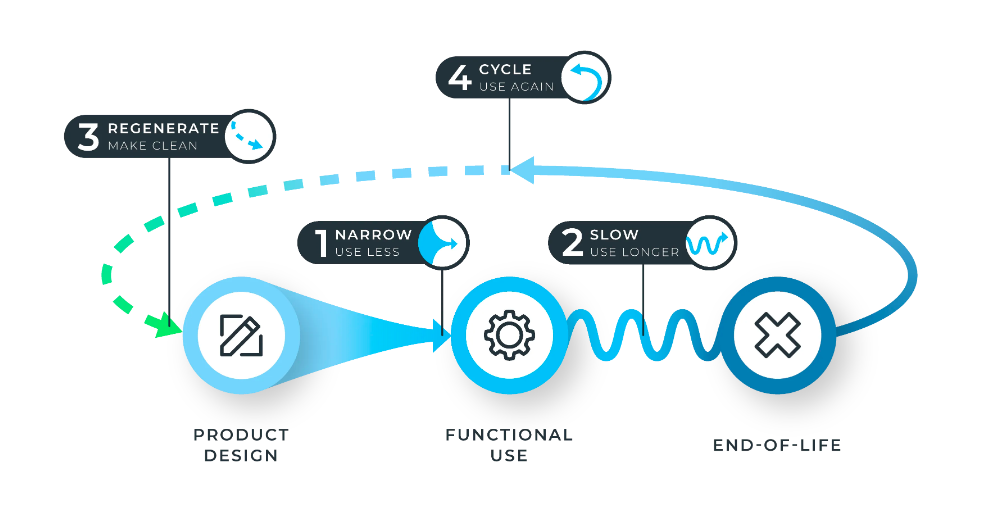
The graphic above depicts the four flows to achieve circular objectives: narrow, slow, regenerate and cycle. The four objectives are based on the work of Bocken et al. (2016)
The focus must centre on getting more value out of fewer materials. Achieving the aims of a circular economy – minimising material use, regenerating the Earth and preventing material losses – can be done through four key strategies:
1. NARROW: USE LESS
Narrow strategies reduce material and energy use. Currently, material use is highly inefficient and ineffective; we can deliver similar social outcomes by using much less and phasing out fossil fuels, for example. This doesn’t mean being worse off, but rather focussing on using materials efficiently: think in terms of riding a bike instead of driving a car, eating less meat and living in a space that suits your needs. Using less is a core tenet of the circular economy—yet currently, the threshold for sustainable consumption, 8 tonnes per person, is being surpassed by 1.5 times.
2. SLOW: USE LONGER
Slow strategies aim to keep materials in use for as long as possible, for example through design for durability and repairability. A more circular economy is also a slower one: materials, components and products – and even buildings and infrastructure – that we lock in stocks are made to last. This will lower material demand in the long run, in essence also serving to narrow resource flows.
3. REGENERATE: MAKE CLEAN
Regenerate strategies phase out hazardous or toxic materials and processes, and substitute them with regenerative biomass resources. A circular economy aims to mimic natural cycles by shifting to more regenerative farming practices, for example, while also maximising the share of circular biomass that enters the economy. Regeneration can happen both at the systems level (by designing regenerative processes) as well as at the product level (by switching synthetic to organic fertilisers, for example).
4. CYCLE: USE AGAIN
Cycle strategies aim to cycle and reuse materials at their highest value: they maximise the volume of secondary materials re-entering the economy, ultimately minimising the need for virgin material inputs and therefore also narrowing flows. Of course, virgin materials will always be needed to a degree: all materials degrade and can’t be cycled infinitely, use energy, and require blending with virgin materials to maintain strength and functionality
Staying within the safe limits of the planet
The Circularity Gap analysis explores how the global economy can meet people’s needs for nutrition, housing, mobility, and manfuactured goods following circular economy principles. The result? A set of 16 circular solutions have been modelled across four global systems: Food systems, the Built environment, Manufactured goods and consumables, and Mobility and transport.
Dive into the solutions and download the full report here: https://www.circularity-gap.world/2023
//
Article source & images: circularity-gap.world

SITRA’s new study: Circular Innovation and Ecodesign in the Textiles Sector
The textiles and apparel industry has a high environmental footprint, and the current production and distribution system is almost completely linear. Fast fashion – speed and volume – has become the norm over the last couple of decades. Moreover, textile production and consumption are expected to triple by 2050. This, in turn, would significantly increase the environmental strains generated by the industry.
Published by The Finnish Innovation Fund Sitra, this study seeks to better understand the opportunities and challenges of an inclusive circular economy transition in the textiles and apparel industry. It takes a deep dive into three developing countries that rely heavily on the EU market for textiles and apparel exports: Bangladesh, Vietnam and Sri Lanka.
Specifically, the study focuses on questions such as:
- What are the implications of the EU’s circular apparel and textiles policy proposals on developing countries exporting textiles and/or apparel products to the EU?
- How can the European Commission’s proposal for the Ecodesign for Sustainable Products (ESPR) be designed so that that it minimises market access implications for developing countries?
- And how can regional trade agreements (RTAs) be leveraged to address circular economy challenges and opportunities in developing countries exporting textiles and/or apparel products to the EU?
The urgency of a circular apparel industry
According to the study, over the past 15 years, apparel sales have almost doubled, reflecting the demand from a growing global middle-class population as well as an increase in per capita sales in advanced economies (Ellen MacArthur Foundation, 2017: 18). As illustrated in Figure 1 below, coupled with the increase in clothing sales is a significant decline in clothing use (UNEP, 2020). This is driven by the “fast fashion” phenomenon, which, through quicker turnarounds of new styles, poorer-quality garments and lower prices, is turning apparel into a single-use commodity. The rapid growth of textiles has largely been enabled by synthetic fibres, produced from oils, which over the past 20 years have grown from under 20% of global fibre production to over 60% of production in 2018 (Textile Exchange, 2018, cited in UNEP, 2020).
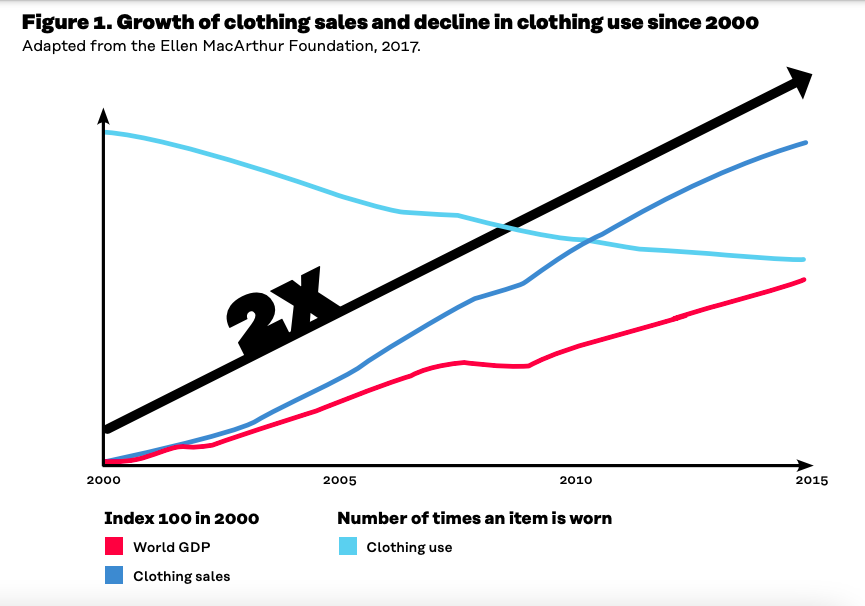
Figure 1 / Sitra
The current system of textile and apparel production and distribution is almost entirely linear. Non-renewable resources, such as oil, fertilisers and chemicals, are extracted and manufactured to produce clothes, which, when discarded, tend to end up in landfills or are incinerated. This process puts pressure on natural resources, degrades ecosystems and generates large amounts of pollution and waste.
It is estimated that, when considering the full life cycle of clothing, the textile and apparel industry generates as much as 3.3 billion tonnes annually in CO2 emissions (HoC, 2019). Put in context, this value exceeds the combined emissions of all international flights and maritime shipping annually.
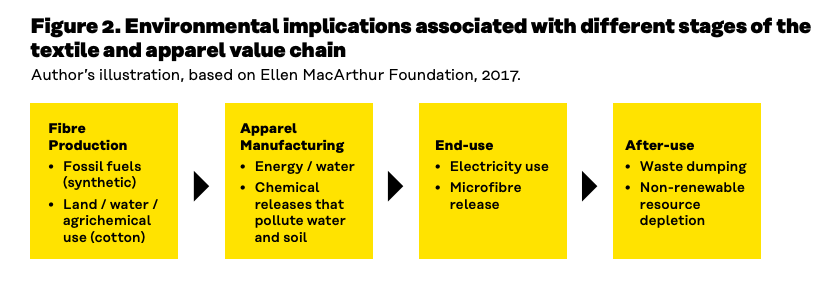
Figure 2 / Sitra
Value chains in the textiles sector are notably international. The EU and other developed countries are major consumers and importers, while a significant part of the large-scale production takes place in developing countries. The EU is the largest importer of clothing worldwide, importing over half its textiles and apparel. 44.9% of all clothing imports to the EU, measured in terms of value, came from developing countries. The successful uptake of new circularity requirements in producer countries will be key to ensuring both global and local environmental benefits as well as opening up valuable new markets and creating jobs. This will not happen by default, however, but requires strategic planning and policy coherence
Key findings
Initiated by Sitra and written by Colette van der Ven, a trade lawyer and sustainability specialist, this study provides analysis and vision for how trade arrangements with the EU could be leveraged to support the transition, offering producer countries – on the example of Bangladesh, Sri Lanka and Vietnam – targeted technical support and investment while minimising the risk of new trade barriers.
Key take-aways include:
- Private vs public sector: Most of the circular textile initiatives in the three countries studied are spearheaded by the private sector, often supported by donor-led initiatives. In each of the three countries studied, voluntary sustainability standards play an important role. This is in part because many companies in the countries studied are foreign owned, with brands pushing for their operations to become more environmentally sustainable. There is, however, a notable absence of government involvement in establishing textile waste-recycling incentives. For effective post-industrial waste management, it would be important for governments to establish adequate regulatory frameworks. Failure to do so would, in a best-case scenario, lead to a bifurcation where foreign-owned companies supplying the export market would adopt circularity principles, while factories supplying the domestic or regional market would continue to engage in linear, and environmentally harmful, practices
- Another observation is that circular economy initiatives adopted in the countries studied seek to reduce the environmental footprint of the product. They do not, however, focus on making the product itself more circular, through enhancing reusability and recyclability in the way the product is designed. This is important for three key reasons: a) most of the added value will take place in upstream design activities – not waste-management activities; b) 80% of the environmental impacts of a product are determined at the design phase; and c) because the ESPR focuses on the circular characteristics of the product itself, not the production process.
Download the study “Circular Innovation and Ecodesign in the Textiles Sector” here.
//
News source & images: Sitra.fi

eBay partners with Reskinned to expand preloved offerings
eBay has announced a new partnership with Reskinned, sustainable preloved clothing repair and resale “specialists”, to expand the online marketplace’s offering of preloved items and reduce growing fashion waste.

Reskinned takes back worn items from shoppers and reconditions them for resale, repurpose or recycling, which keeps the articles out of landfill and extends the product’s life.
The new partnership represents an expansion of eBay’s offering of preloved clothing to include a wide range of items which have been repaired and made fit for resale. It will also connect Reskinned with the marketplaces’ over 20 million shoppers through a “brand approved” shopfront.
In 2021, eBay says it helped save over 17,770 tonnes of fashion items out of landfill – the equivalent of 1,404 double-decker buses.
//
News source: circularonline.co.uk
Images: reskinned.clothing

The Circularity Gap Report 2022: the world is only 8,6% circular
In 2017, Circle Economy recognised the urgent need to accurately measure the circular economy. So far, there was no global baseline measurement on the circular state of our world or data available to truly understand how we can effectively move towards circularity or monitor progress.
That is why, in January 2018, the first Circularity Gap Report was published during the World Annual Forum in Davos. This first report established that our world is only 9.1% circular, leaving a massive circularity gap. It also provided a framework and fact-base to measure and monitor progress in bridging the global circularity gap. In January 2019 the second edition of the Circularity Gap Report was launched, reiterating that our global economy is stuck in reverse and failing people and the planet.
From 9.1% to 8.6% circular: What is going on?
From the bicycles we ride, to the books we read and the buildings we inhabit, nearly all facets of daily life are shaped by materials. And as we do more – be it travelling, buying goods and even eating – we use more resources. Of the 100 billion tonnes of resources that the world uses every year, by 2022 only 8.6% is cycled back into our economy: over 90% of what we take from the earth to fulfil our needs and wants goes to waste – our throwaway society in practice.
This rate of extraction continues to threaten the planet’s future – and our lives on it. Yet forecasts paint a grim future: according to the International Resource Panel, material use may increase to between 170 and 184 billion tonnes in 2050 if business as usual prevails.
The circular economy provides a framework for decoupling growth from material extraction: it can create the conditions for sustainable development, meeting the needs of the growing population without relying on the use of primary resources.
Three consecutive Circularity Gap Reports were devoted to answering the question of how circular the global economy is and identifying the key levers to move us towards circularity with a focus on mass. Initially, the inspiration came from the UN’s Emissions Gap reports – and for the 2021 analysis, the Emissions Gap returned to the fore, with the task of quantifying how closing the Circularity Gap could also help to close the Emissions Gap.
Only two years after the 9.1% measurement, the analysis found that the circularity of the world had fallen to 8.6%. And we now know that material use is not only increasing, but accelerating beyond even population growth. Since 1970, the American population has grown by 60%, disproportionately accompanied by an increase in consumer spending of 400%: a trend common among nations with an expanding middle class.
It was found that our climbing rates of resource use are responsible for catapulting billions of tonnes of human-made GHGs (greenhouse gases) into our atmosphere – 70% of emissions, to be precise. In 2019 alone, we emitted 59.1 billion tonnes of GHGs to satisfy global needs and wants. The Circularity Gap Report 2021 quantitatively mapped how GHG emissions and resources move through our economy, from extraction to end-of-use.
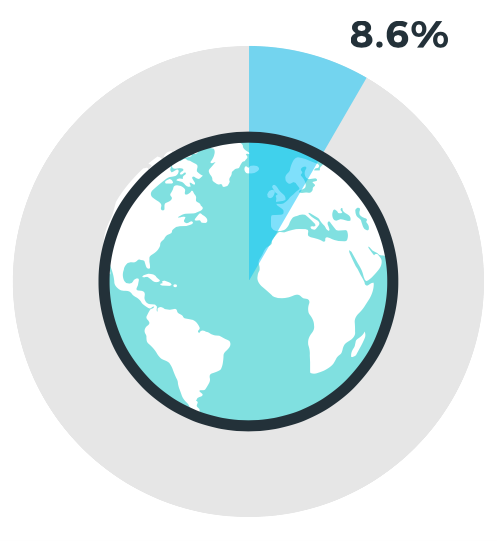
What is causing this negative shift?
Overall it can be explained by two related, underlying trends:
1. Our growth rate of resource extraction outpaces improvements in efficiency and in end-of-use recovery by a factor of two to three – and as a result, the quantities of secondary materials available for use are falling short.
Ultimately, our limited capacity to cycle materials at an equal level around the world means that quantities of secondary materials available for reuse fall short: we still need huge amounts of virgin materials to satisfy our lifestyles. Overall material consumption must also be reduced to narrow flows: if the common denominator (consumption of primary materials) keeps growing, our advances in material efficiency and cycling can never keep up. The processes still entail resource extraction.
2. To serve the needs of a growing population, we keep extracting materials to build housing, infrastructure and heavy machinery – we should make use of what is already there.
Countries are continually investing in new buildings and infrastructure to meet a variety of societal needs. Current estimates suggest that 255 billion square metres of buildings exist across the globe – a figure expected to almost double within the next four decades. This is equal to erecting cities the size of Paris every week. This stock build-up is not inherently bad; many nations need to invest to ensure access to basic services. But as our global population is projected to swell to 9.9 billion over the next 30 years and land-use concerns come to the fore, we’re increasingly building up.
This is concerning as tall buildings are inherently unsustainable: skyscrapers require extra resources for foundational and structural support: namely, cement. Cement use is extremely emissions-intensive but demand continues to rise. Also, increasing renewable energy generation, distribution and storage capacity to regenerate energy flows will entail building up infrastructure, such as wind turbines or electrical grids. Fortunately, this is happening at scale: G20 members have set new records in building capacity for solar and wind power – nearly doubling the amount of wind power produced in 2020 compared to 2019.
Regardless, when materials, mostly minerals and ores, are invested into stock in the form of buildings, infrastructure and heavy machinery, they become embedded and unavailable as secondary materials for as long as they remain stored and in use. It is, therefore, paramount that virgin resources are not extracted to continue building up this stock, but rather that we design, produce, maintain and reuse buildings, roads and machinery in a circular manner to cycle flows.
Mobility, Housing and Nutrition account for almost 70% of global emissions
- Mobility has the largest emissions footprint at 17.1 billion tonnes – largely due to fossil fuel use across passenger and freight transport. The production of automobiles, trucks, trains and aeroplanes is relatively limited in emissions contributions.
- Housing, at 13.5 billion tonnes of emissions, has the second largest contribution. This is due to the vast extraction, transport and construction activities it entails, as well as the energy used to light, heat and cool our homes.
- Third in line is the provision of food for Nutrition, which contributes 10 billion tonnes of emissions.
- Land use, land-use change and forestry (LULUCF) – a GHG inventory sector referring to emissions from human land-use activities – is associated with the production of food, but also fibres and clearing for the expansion of urban centres, and is responsible for about 4 billion tonnes of emissions.
- The remaining 30% of emissions flow into satisfying our need for Communications, Services, Consumables and Healthcare.
21 Circular solutions for a 1.5 degree pathway
The 2022 report presents a roadmap of 21 interventions across six scenarios that can mitigate climate impact by curbing GHG emissions. You can see the roadmap here.
Some interventions overlap, which means that the total combined effect is significantly less than when all individual interventions are simply added together. This is because some interventions, when combined, will partially cancel each other out. For example, in ‘Reduce floor space’, we also reduce the volumes of construction and demolition waste (C&DW) that become available for recycling and repurposing. Another example is the absolute impact of lightweighting the global car fleet in ‘Vehicle design improvements’, which is directly moderated by the size of the said fleet, which in turn is reduced by, for instance, car sharing.
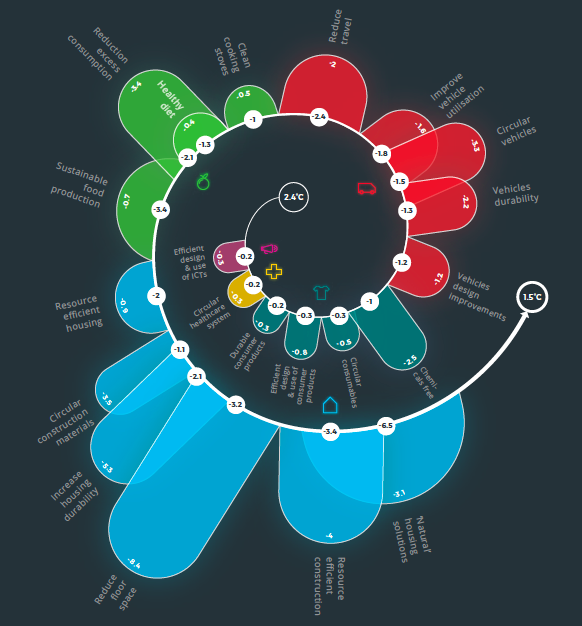
Together, the combined interventions can almost double the current global Circularity Metric of 8.6%, bringing it to 17%. This results in:
- Shrinking global material use and extraction by 28%.
- Cutting global GHG emissions by 39% – fully closing the Emissions Gap as defined in our report and taking into account the updated NDCs.
- Allowing the world to achieve the Paris Agreement’s goal of keep at 1.5-degrees of warming by 2032.
//
Article source & images: https://www.circularity-gap.world/2022



